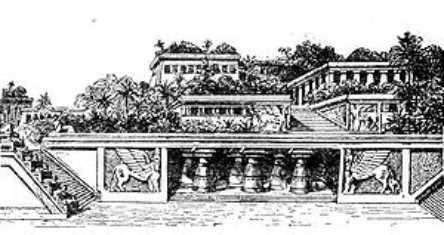
The Hanging Gardens were built by Nebuchadnezzar II around 600 B. C. He is said to have built them to please his wife, Amyitis of Media, who longed for the mountainous countryside of her land. They are extensively documented by Greek historians, although the Hanging Gardens were never seen by any and are the only Wonder to have not certainly existed. Tablets show the use of Archimedes' screws to raise water and stone slabs to prevent the water from eroding the ground. They were destroyed by Xerxes II of Persia around 480 B. C.
The garden has been described as rectangular, 400 ft. (122 m.) square, with arched vaults, screw-like water pumps, and many stairways, made of baked brick and asphalt, and placed right next to the Euphrates by Strabo; 100 ft. (30 m.) square, with tiers, vaults, walls, rich, deep dirt, and water pumps, made of baked brick and cement by Diodorus; having terraces, walls, balconies, rich, deep dirt, pipes, and machinery by Anaximenes. The word hanging is probably an inexact translation from the Greek or Latin and actually should be overhanging, referring to the terraces.
The gardens were probably watered with a chain pump. A chain pump consists of two wheels, one higher and one lower, with a chain going around them. Buckets are placed on the chain and the lower wheel is placed close enough to a water source that the buckets get dipped in it. The upper wheel is placed very close to what you want watered and as the buckets go around, they empty into whatever you want watered. The remains of what might have been the Hanging Gardens were discovered in 1899 by Robert Koldeway, but although they matched many of Diodorus' details, they were too far from the Euphrates. The river could have changed its course in the past millennia, of course.